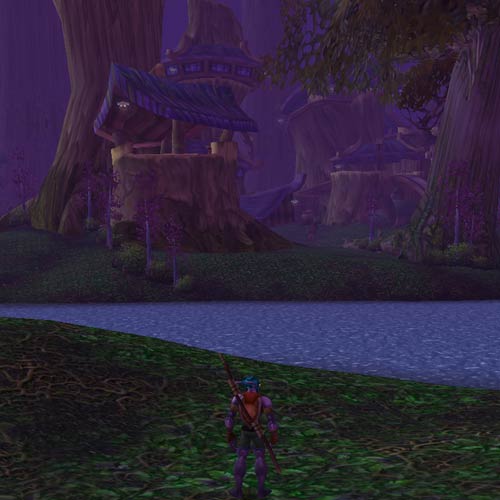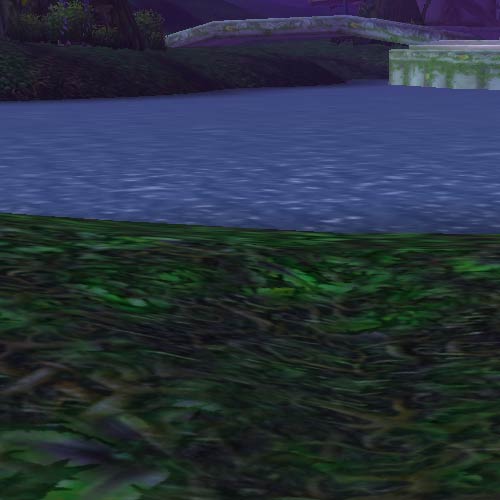
Original Link: https://www.anandtech.com/show/1649
World of Warcraft Performance Guide
by Anand Lal Shimpi on March 23, 2005 12:17 PM EST- Posted in
- GPUs
In PC gaming, first person shooters get all of the attention. The releases of Doom 3 and Half Life 2 were accompanied by a swarm of hardware upgrade guides all over the net, including those published on AnandTech. If you were waiting for Doom 3 or Half Life 2 before upgrading your machine, you had every ounce of information at your disposal upon their release.
The same type of attention is rarely cast on other genres of games in the PC world for a handful of reasons. For starters, FPSes are the most likely to have built-in benchmarking tools, making our ability to present you with performance data infinitely easier. There's also a good deal of emotional attachment to anything that comes out of id Software, Epic Games or Valve, given their history with PC games - in their own way, they are the developers who brought the PC its Super Mario Brothers or Legend of Zelda. But reasoning aside, there's much more to PC gaming than just FPSes; the best, most recent, example of an extremely successful non-fps is none other than Blizzard's foray into the Massively Multiplayer Online Role Playing realm - World of Warcraft.
MMORPGs, like World of Warcraft, rely on hordes of subscribed users (hence the massively multiplayer aspect); otherwise, they lose a big chunk of their appeal. World of Warcraft has been particularly successful in this respect. Earlier this month, Blizzard announced that WoW had reached over 1.5 million subscribers worldwide, with over 800,000 subscribers in North America alone. At any given time, there are over 500,000 users logged into one of Blizzard's many WoW servers at a speed of adoption never before seen in the MMORPG market. But as we saw with the introduction of Warcraft III, anything Warcraft from Blizzard is not only well done, but turns to gold upon release.
Given the tremendous market penetration of WoW, we felt that it was time to take a look at its performance demands. But unlike Doom 3 and Half Life 2, there is no static element of WoW gameplay - everything takes place in an ever-changing online world. The result is that finding a repeatable benchmark to run is fairly difficult...but not impossible. As a MMORPG, World of Warcraft doesn't depend on the razor-sharp reaction time of a fast-paced first person shooter; instead, you spend most of your time walking around performing quests and battling at a much slower pace, in a much larger, more interactive world. As such, there are two scenarios when performance in WoW becomes an issue: when a lot of characters are present on the screen, and simply rotating the camera in the world. The former is a virtually impossible scenario to use as a benchmark, as you can't reliably get a bunch of people to do the exact same thing at the exact same time in a repeatable fashion, but the same can't be said about scenario 2. The world of Warcraft is truly enormous and in order to prevent overcrowding, there is a large number of servers for you to choose on which your character may play - each server has a complete copy of the Warcraft world. Even on the highest populated servers (one of which we conducted our test), there are many areas where you can go that are devoid of any player controlled characters - making them ideal for benchmarking. We chose one such spot in the Night Elf city of Darnassus.
The other aspect of WoW that played into our favor was the fact that exiting and returning to the game using the same character always put you in the world at the exact same place. Equipped with FRAPS, we were able to get an extremely repeatable average frame rate out of a sequence of five full camera rotations in our chosen spot in Darnassus. The number of rotations ensured that minor variations such as a squirrel walking across the screen would have minimal impact on the benchmark, and the results backed that up. We found a maximum of 3% variation between runs as long as there was no disk swapping that occurred during the benchmark (more on that later). The only downside is that our benchmark is not externally reproducible, but similar techniques can be used to achieve a similar end result. We did have one user search us out in the world and interrupt our benchmarking by asking us if we had any linen cloth, but after a quick "no", we were back to benchmarking without being disturbed.
Graphically, WoW isn't another Doom 3 or Half Life 2; it's not pushing the limits of DirectX 9 nor is it going to knock your socks off visually. For a MMORPG, it looks pretty good, similar to Warcraft III, but obviously much more detailed, since you are taking the perspective of a single character in the world of Warcraft, rather than controlling an army from up above.
Blizzard states the minimum GPU requirement as a GeForce 2; while a GeForce 2 will run the game just fine at lower resolutions and detail settings, it will do so at the sacrifice of a good amount of image quality. Below, we have a comparison between a playable WoW system on a GeForce4 MX (GeForce 2 class DirectX 7 hardware) and on a Radeon X800 (DX9 hardware). You'll see a DX7 screenshot, and mouse over to see the same scene running on DX9 hardware:
How much slower is a GeForce4 than a Radeon X800? That comparison and many more is the subject of our first comparison...
The Test
Our hardware configurations are similar to what we've used in previous comparisons.
AMD Athlon 64 Configuration
Socket-939 Athlon 64 CPUs
2 x 512MB OCZ PC3200 EL Dual Channel DIMMs 2-2-2-10
NVIDIA nForce4 Reference Motherboard and MSI K8N-Neo2 (nForce3) for AGP tests
Intel Pentium 4 Configuration
LGA-775 Intel Pentium 4 and Extreme Edition CPUs
2 x 512MB Crucial DDR-II 533 Dual Channel DIMMs 3-3-3-12
Intel 925XE Motherboard
AMD Athon XP Configuration
Athlon XP 3200+ Barton CPU
2 x 512MB OCZ PC3200 EL Dual Channel DIMMs 2-2-2-10
ASUS nForce2 Motherboard
ATI's Catalyst 5.3 and NVIDIA's ForceWare 71.84 Drivers were used.
World of Warcraft Video Options
There is a surprising number of options for adjusting image quality in World of Warcraft:
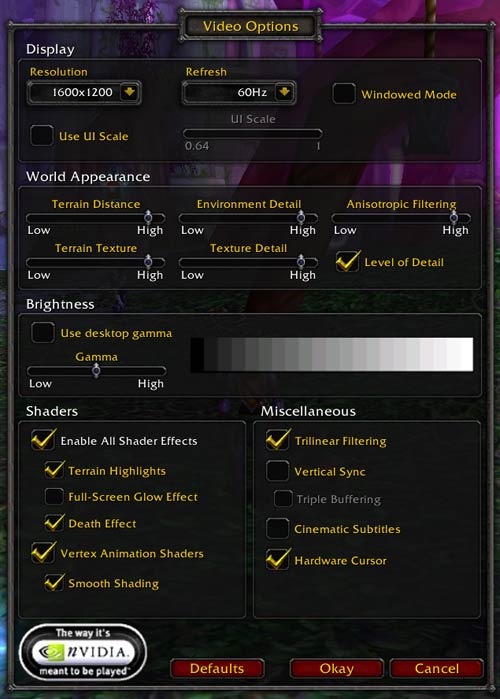
There are a handful of "shader effects" that will run on both DX8 and DX9 hardware (and are basically indiscernible between the two classes of hardware), most of which provide minor changes in image quality. There is one exception, the Full-Screen Glow Effect shader, which we found to be a bit over the top. This shader, in particular, makes WoW look a lot like a Playstation 2 game as you can see from the screenshots below.
Mouse over the image below to see Full-Screen Glow enabled.
The newer cards take a much lower performance hit from maxing out the anisotropic filtering slider and they end up looking better too.
We wanted to be able to directly compare all GPUs, so we maxed out all of the sliders and options (with the exception of the Glow effect and V-Sync). The screenshot above of the Video Options screen is actually the settings that we used for benchmark (varying only resolution).
ATI vs. NVIDIA Image Quality
Both ATI and NVIDIA do a good job with image quality in WoW. Playing through the game, we couldn't pinpoint any differences in image quality between the latest ATI and NVIDIA drivers.
ATI Radeon X850 XT
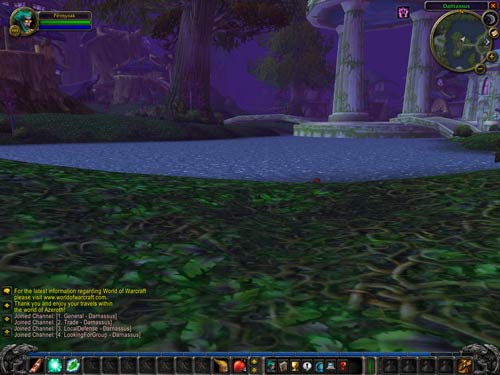
NVIDIA GeForce 6800 Ultra

Even the NV3x GPUs had no problems in WoW, although their anisotropic filtering quality seemed to suffer in comparison to the latest GPUs.
NVIDIA GeForce 5900XT
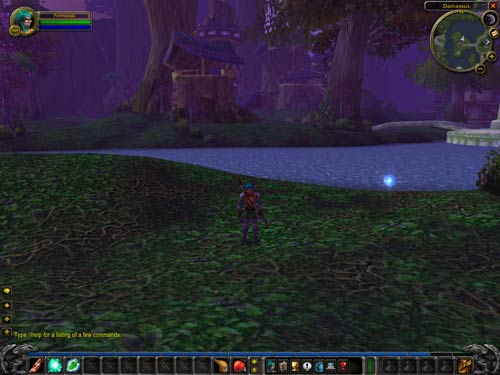
WoW GPU Performance
We tested a total of 12 GPUs, mostly modern day DX9 hardware. But even at 12, we didn't get as much testing done as possible. This week's WoW patch threw a wrench in our testing, which forced us to keep a couple of cards out of the comparison, mainly the Radeon 9800 Pro and the Radeon 9600XT. Thankfully from a performance perspective, the Radeon 9800 Pro behaves very similarly to the X700 Pro (a bit slower, but nothing huge), so you will at least have a reference point if you are a current 9800 Pro owner.


Much to our surprise, performance was fairly balanced between ATI and NVIDIA at similar product points. The GeForce 6800 Ultra performed very similarly to the Radeon X850 XT, as did the 6800GT and the X800 XL. The major exception being the 6600GT vs. the X700 Pro, where the 6600GT offers significantly better performance.
The GeForce 6200 performed exceptionally well given that it is a sub-$100 card. At 1024 x 768, its performance was quite acceptable in WoW (remember that 20 - 30 fps is a lot more playable in a slow-paced FPS).
It did take the fastest GPUs to actually offer uninterruptible smooth performance (i.e. no stuttering) at the higher resolutions. The X850 XT and the 6800 Ultra were both capable of that at 1600 x 1200.
WoW CPU Performance
A fast CPU is just as important to WoW as a fast GPU, which is generally the case in any modern day 3D game. We looked at performance across 18 CPUs on a X800 XT at 1024 x 768, using the same settings as our GPU comparison.

Intel is remarkably competitive here; while they normally get completely demolished by AMD in gaming performance, the margins are much closer this time around. At higher resolutions, the AMD-Intel gap would effectively disappear between most competitors. Our recommendation here is to focus on getting a good video card and picking the platform that is more affordable and better suited to your needs.
The Athlon XP is clearly behind the times here, but given its age, it is not too surprising to see it at the bottom of the charts. Athlon XP owners will probably want to upgrade to an Athlon 64 or Pentium 4 before seeking out a faster video card in order to maximize their upgrade dollars.
There is one interesting phenomenon that we noticed when looking at Intel's WoW performance - the Pentium 4 600 series first performs poorer, clock for clock, than the 500 series, but at higher clock speeds, it actually outperforms the 500 series. Given that the Pentium 4 600 has a 17% higher latency L2 cache, that added cache latency is more pronounced at lower clock speeds. Once again, the difference in performance (clock for clock) isn't large enough to sway our recommendation either way. We'd still suggest the 600 series over the 500 simply because of the added features.
Final Words
The balance between GPU and CPU performance isn't all that matters to World of Warcraft. Memory size is also a very important factor in building a smooth running WoW box. As with any high end gaming box, less than 512MB of memory is simply unacceptable for WoW. However, the requirements here are a little more strenuous than usual. We found that ideally, you need 1GB of memory to have WoW running on a machine that has other applications running in the background. While you can get by with less than that, for the best overall performance, the sweet spot is 1GB. With memory prices at the lowest that they will be for the next few months, making that 1GB or more upgrade is a bit easier now than it was before or than it will be later on.
Blizzard has also done a good job of providing Mac support for World of Warcraft. In fact, the same discs used to install the PC version will work in installing the Mac version of WoW. Unfortunately, Mac WoW performance is nothing to write home about. Performance on a dual G5 2.5GHz with an ATI Radeon X800 XT Mac Edition is less than half of the performance of a single Athlon 64 4000+ and a Radeon X800 XT. The performance on slower video cards is just as disappointing. Blizzard has been active in improving Mac WoW performance, but the gap remains to be nothing short of huge. Mac OS X has never been known as a gaming platform of choice, but Mac users should at least be able to run the games to which they do have access at comparable frame rates to their PC counterparts. Regardless of whether the Mac WoW performance issues are the fault of Apple, Blizzard or the GPU vendors, they need to be fixed if any of the responsible companies actually care about that user base. WoW is quite playable on the Mac - it's just noticeably slower than on the PC.
From an overall standpoint, World of Warcraft is much more demanding of a game than it seems. The game is quite playable on older hardware, and visually, it looks very similar even on DX8 class GPUs, but higher resolutions and getting rid of irritating choppiness when rotating your camera in the world are both enabled through faster GPUs and CPUs.
WoW is generally more GPU limited than CPU limited, but you still need a relatively fast CPU. On the AMD side, the Athlon 64 3500+ continues to be the sweet spot, while the Pentium 4 650/550 is the more balanced choice for Intel folks. And as always, we found that the Extreme Edition is a waste of money.
But if you happen to have a relatively new Athlon 64 or Pentium 4 system, you're pretty much good to go. The biggest need for a CPU upgrade will be lower clocked Northwood and Athlon XP based systems.
As far as GPUs go, the more you spend, the higher the resolution that you can run and the smoother that things will be at that resolution. The ATI vs. NVIDIA decision is really up to you for most GPUs except at the lower price points, where the 6600GT and the 6200 both outclass their ATI competitors.
If you're one of the 1.5 million people who has found themselves addicted to World of Warcraft, you might as well feed your hardware addiction at the same time, right?

